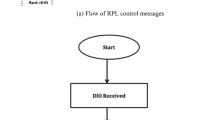Abstract
Routing Protocol for Low power and lossy networks (RPL) is the underlying protocol of 6LoWPAN, a core communication standard for the Internet of Things (IoT). The concept of rank is used in RPL for routing and its optimization. However, the rank provides an avenue for “Rank Attacks (RA)” like worst parent, increased rank, and decreased rank, which are internal to 6LowPAN. In this paper, a smart building scenario with intelligent edges is considered for detecting the worst-parent attacks of RPL. Novelty of our approach is that, in addition to detecting the attack, the impact of the malicious node location on the average statistics of control messages is used to identify its locality, using Machine Learning (ML) classification at the edge of the network. An “impact factor” has been defined and analyzed in terms of the forwarding load of the node. Simulation results obtained for a given static node topology, show a localization accuracy of 0.67 using Support Vector Method (SVM), while the accuracy obtained using eXtreme Gradient Boost (XGBoost) is 0.88. Discussion on how the technique is applicable to any generalized network topology, to reduce the number of packet level inspections for malicious node detection, is also presented.
Access this chapter
Tax calculation will be finalised at checkout
Purchases are for personal use only
Similar content being viewed by others
References
Shelby, Z., Bormann, C.: 6LoWPAN- The Wireless Embedded Internet, vol. 43. Wiley, New York (2011)
RPL: IPv6 Routing Protocol for Low Power and Lossy Networks, RFC Standard 6550, Mar (2012)
Verma, A., Ranga, V.: Evaluation of network intrusion detection systems for RPL based 6LoWPAN networks in IoT. Wireless Pers. Commun. 108(3), 1571–1594 (2019)
Boudouaia, M.A., Ali-Pacha, A., Abouaissa, A., Lorenz, P.: Security Against Rank Attack in RPL Protocol. IEEE Network 34(4), 133–139 (2020)
Le, A., Loo, L., Lasebae, A., Vinel, A., Chen, Y., Chai, M.: The impact of rank attack on network topology of routing protocol for low-power and lossy networks. IEEE Sens. J. 13(10), 3685–3692 (2013). https://doi.org/10.1109/JSEN.2013.2266399
Khraisat, A., Alazab, A.: A critical review of intrusion detection systems in the internet of things techniques, deployment strategy, validation strategy, attacks, public datasets, and challenges. Cybersecur 4, 18 (2021). https://doi.org/10.1186/s42400-021-00077-7A
Said, A.M., Yahyaoui, A., Abdellatif, T.: Efficient anomaly detection for smart hospital IoT systems. Sensors 21(4), 1026 (2021)
Almusaylim, Z.A., Jhanjhi, N., Alhumam, A.: Detection and mitigation of rpl rank and version number attacks in the internet of things: SRPL-RP. Sensors 20(21), 5997 (2020)
Wadhaj, I., Ghaleb, B., Thomson, C., Al-Dubai, A., Buchanan, W.J.: Mitigation mechanisms against the dao attack on the routing protocol for low power and lossy networks (RPL). IEEE Access 8, 43665–43675 (2020)
Farzaneh, B., Montazeri, M.A., Jamali, S.: An anomaly-based IDS for detecting attacks in rpl-based internet of things. In: 5th International Conference on Web Research (ICWR), pp. 61–66 (2019)
https://thenewstack.io/azure-iot-edge-a-technology-primer/, Accessed 1.06.2021
Mayzaud, A.: Monitoring and Security for the RPL-based Internet of Things. Cryptography and Security [cs.CR]. Université de Lorraine, (2016)
Le, A., Loo, J., Luo, Y., Lasebae, A.: Specification-based IDS for securing RPL from topology attacks. In: IFIP Wireless Days (WD), pp. 1–3 (2011)
http://anrg.usc.edu/contiki/index.php/Cooja_Simulator. Accessed 1 June 2021.
https://towardsdatascience.com/understanding-boxplots-5e2df7bcbd51. Accessed 1 June 2021
https://www.datacamp.com/community/tutorials/svm-classification-scikit-learn-python. Accessed 1 June 2021
Chen, T., Guestrin, C.: XGBoost: A Scalable Tree Boosting System. In: Proceedings of the 22nd ACM SIGKDD International Conference on Knowledge Discovery and Data Mining, pp. 785–794 (2016)
Author information
Authors and Affiliations
Corresponding author
Editor information
Editors and Affiliations
Rights and permissions
Copyright information
© 2022 The Author(s), under exclusive license to Springer Nature Switzerland AG
About this paper
Cite this paper
Sasirekha, G.V.K., Bhanu Prakash, V., Bapat, J., Das, D. (2022). Localizing Worst-Parent Rank Attack Using Intelligent Edges of Smart Buildings. In: Gude Prego, J.J., de la Puerta, J.G., García Bringas, P., Quintián, H., Corchado, E. (eds) 14th International Conference on Computational Intelligence in Security for Information Systems and 12th International Conference on European Transnational Educational (CISIS 2021 and ICEUTE 2021). CISIS - ICEUTE 2021. Advances in Intelligent Systems and Computing, vol 1400. Springer, Cham. https://doi.org/10.1007/978-3-030-87872-6_7
Download citation
DOI: https://doi.org/10.1007/978-3-030-87872-6_7
Published:
Publisher Name: Springer, Cham
Print ISBN: 978-3-030-87871-9
Online ISBN: 978-3-030-87872-6
eBook Packages: Intelligent Technologies and RoboticsIntelligent Technologies and Robotics (R0)




